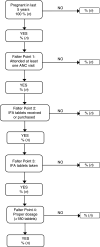Iron+folic acid distribution and consumption through antenatal care: identifying barriers across countries
- PMID: 26022914
- PMCID: PMC10270815
- DOI: 10.1017/S1368980015001652
Iron+folic acid distribution and consumption through antenatal care: identifying barriers across countries
Abstract
Objective: The prevalence of maternal anaemia remains unacceptably high in developing countries. At the same time, the percentage of women who consume one or more Fe+folic acid (IFA) tablets during pregnancy remains persistently low. The objective of the present study was to identify where, within antenatal care (ANC) programmes, pregnant women falter in obtaining and consuming an ideal minimum of 180 IFA tablets.
Design: Data from Demographic and Health Surveys were used to develop a schematic which identifies four sequential 'falter points' to consuming 180 IFA tablets: ANC attendance, IFA receipt or purchase, IFA consumption and the number of tablets consumed.
Setting: Twenty-two countries with high burdens of undernutrition.
Subjects: A sample of 162 958 women, 15 to 49 years of age, with a live birth in the past 5 years.
Results: Across all countries, 83 % of all pregnant women had at least one ANC visit, 81 % of whom received IFA tablets. Of those receiving IFA tablets, 95 % consumed at least one. Overall adherence to the ideal supplementation regimen, however, was extremely low: only 8 % consumed 180 or more IFA tablets. There were only two countries in which the percentage of pregnant women consuming 180 or more tablets exceeded 30 %.
Conclusions: While most women receive and take some IFA tablets, few receive or take enough. The analysis identifies where ANC-based distribution of IFA falters in each country. It enables policy makers to design and prioritize follow-up activities to more precisely identify barriers, an essential next step to improving IFA distribution through ANC.
Keywords: Anaemia; Antenatal care; Iron+folic acid; Maternal anaemia; Supplementation.
Figures


 , ≥180;
, ≥180;  , 135–179;
, 135–179;  , 90–135;
, 90–135;  , 45–89;
, 45–89;  , <45) by number of ANC visits among a sample of 162 958 women (aged 15–49 years with a live birth in the past 5 years) from twenty-two countries that had a DHS completed during or after 2005 (IFA, Fe+folic acid; ANC, antenatal care; DHS, Demographic and Health Survey)
, <45) by number of ANC visits among a sample of 162 958 women (aged 15–49 years with a live birth in the past 5 years) from twenty-two countries that had a DHS completed during or after 2005 (IFA, Fe+folic acid; ANC, antenatal care; DHS, Demographic and Health Survey)References
-
- Mason J, Martorell R, Saldanha L et al.. (2013) Reduction in anaemia. Lancet Glob Health 1, e4–e6. - PubMed
-
- Stevens GA, Finucane MM, De-Regil LM et al.. (2013) Global, regional, and national trends in haemoglobin concentration and prevalence of total and severe anaemia in children and pregnant and non-pregnant women for 1995–2011: a systematic analysis of population-representative data. Lancet Glob Health 1, e16–e25. - PMC - PubMed
-
- World Health Organization (2001) Iron Deficiency Anaemia. Assessment, Prevention and Control. A Guide for Program Managers. Geneva: WHO.
-
- Black RE, Victora CG, Walker SP et al.. (2013) Maternal and child undernutrition and overweight in low-income and middle-income countries. Lancet 382, 427–451. - PubMed
Publication types
MeSH terms
Substances
LinkOut - more resources
Full Text Sources
Medical
Miscellaneous

